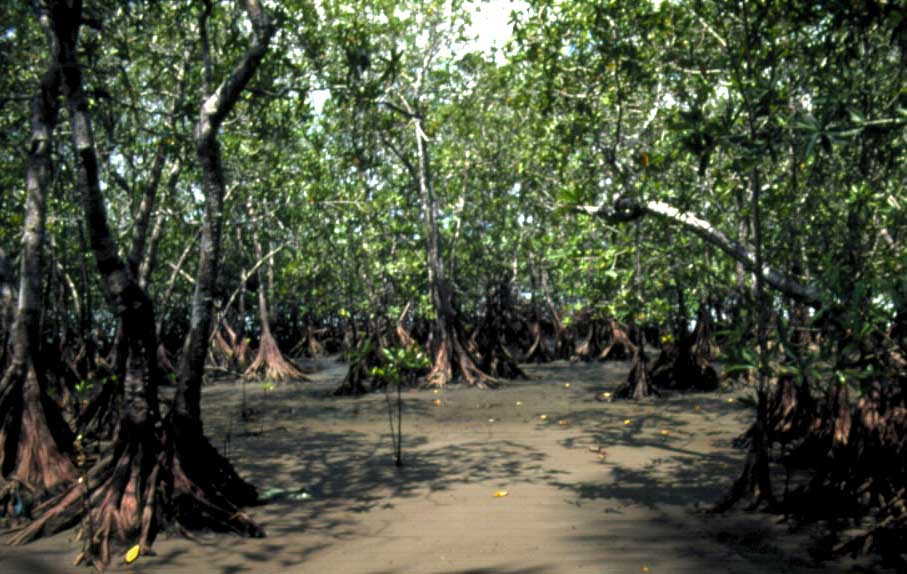Tidal Mangrove Swamp
By: Darcie Mather
 Tidal Mangrove Swamp- are also known as tidal mangrove forest. It is a swampy very damp ecosystem that is best known for their fauna. Plants in a tidal mangrove are very distinct because their roots are very exposed but most often grow into the water (as shown in the picture). Side note all of the mangroves in Costa Rica are protected by law.
Tidal Mangrove Swamp- are also known as tidal mangrove forest. It is a swampy very damp ecosystem that is best known for their fauna. Plants in a tidal mangrove are very distinct because their roots are very exposed but most often grow into the water (as shown in the picture). Side note all of the mangroves in Costa Rica are protected by law.
Defining Feature:
-
Houses many types of algae
-
Tree/plant roots are very exposed
-
Mix of fresh/salt water very saline
-
Salt builds up on the leaves sometimes
-
Inter-tidal zone meaning it has a varying range of tide level
-
The mud has low oxygen levels
-
Helps to limit long term erosion

Location:
Tidal Mangrove Swamps are found only in the subtropics/tropical areas. Such as Africa, South America, some parts of North America and places in Central America like Costa Rica. Mangroves are attracted to areas of little water movement the less waves the better for these ecosystems. The Tidal Mangrove Swamps located in Costa Rica are more specifically found on the Osa Peninsula on the southern Pacific side of Costa Rica. Unfortunately we will not be visiting the Tidal Mangrove Swamps during our trip to Costa Rica.
(The Osa Peninsula is located at the bottom right corner just off of Panama)

 Temperature/Precipitation:
Temperature/Precipitation:
-
Tidal Mangrove Swamps are found to grow best in temperatures 19°C (66°F) or higher
-
If the temperature fluctuates more than 10 degrees celcius in a short period of time the mangroves can not survive either
-
There precipitation averages annually about 4.5 meters
-
During the rainy season when most of the rain falls the salinity (salt) decreases greatly because the rain washes it away
The rainy season tends to flood the rivers of the mangrove causing high tides
-
During the dry season it becomes very saline with some trees producing salt crystals on their leaves
The dry season tends to be when the water recedes causing low tides
Animals-some of the major animals that live in a tidal mangrove swamp are oysters, sponges, mangrove crabs, lobsters, shrimp, and the white faced monkey.


Mangrove crabs are bottom feeders and improve the environment of the tidal mangrove swamp ecosystem because they eat all of the dead leaves.
We are guaranteed to see this little guy there!

Fauna-the trees in the mangrove house many types of algae, but what the tidal mangrove swamp has most of is mangrove trees. There are many different types of mangrove trees black mangrove, white mangrove, red mangrove, mangrove apple, and tea mangrove are some of the more popular trees in the mangrove. There are things other than trees in the mangrove there is the mangrove palm, the  buttonwood mangrove, and a few other various plants that have developed the exposed rooting system that the mangrove trees have.
buttonwood mangrove, and a few other various plants that have developed the exposed rooting system that the mangrove trees have.
The Red mangrove tree is the most distinct and easiest to recognize out of all of the mangrove trees because not only does their bark have a slight reddish tint to it hence the name but their roots

toend to branch off two or three times before ever reaching the ground or water.
In Costa Rica all types of mangrove trees are called a mangle because they grow in groups called mangles. However, this tree (See left) is really a black mangrove.

The mangrove apple is also very easy to distinguish because as its name would suggest it produces apples. The apples may be a tasty snack for animals but they also make a good treat for humans too. They are rumored to taste like cheese. Although they do not grow in the mangrove of Costa Rica.
The tea mangrove is very populous in the Costa Rican mangroves. They produce an odd top shaped fruit (left picture) that is about the size of an onion and produces one of the biggest seeds in the world. The tree is so populous in the mangroves because its seeds can fall off the tree and just seep into the damp ground making germinization easier.

Some types of fauna other than trees in the mangrove are the mangrove palm which is as it sound like a palm. Its roots are still exposed like all of the other plants in the mangrove. The mangrove palm is also  refered to the Nypa palm and is found all over the Costa Rican mangroves.
refered to the Nypa palm and is found all over the Costa Rican mangroves.
The last plant that is well known in the mangrove is the buttonwood mangrove. It is a shrubby plant found on the edge of the river. It grows best in areas where the wind is breezy. It is reddish brown and produces cone like fruit.
Comments (0)
You don't have permission to comment on this page.